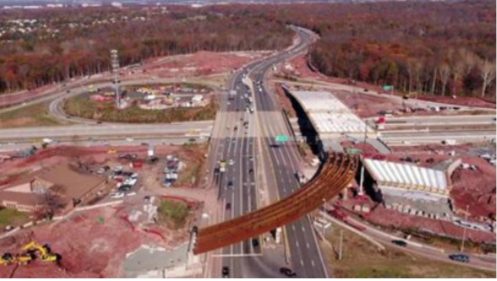Off the Property

OK- The Writers Section is ready to talk about Infrastructure. We voted dead even on the matter, and then had to call in someone from another sector who knew nothing about the issue to decide it fairly. The whole thing has been a little complicated, since there was disagreement about what it was we were talking about. For example, when the Loading Dock was constructed to better utilize the Barn, there was agreement about concrete footings, power lift from Gillespie Elevation Systems, and new automated handling machines. Once completed, of course, it was used as a smoking area.
A similar detailed process is being followed up the road in Yorur Nation’s Capital. Spending for Infrastructure follows the same rigorous planning, like Lifetime Childcare from birth to old age. We are in general agreement that being a rural expats through the National Emergency has considerably lessened my criteria for adventure. I was selected to take a jolt of reality yesterday, since Rocket, Loma, DeMille and the others decided to take extended luncheons for internal infrastructure fortification.
It was almost like being back in the working world. There was the in-person meeting with a small speaking part. A long drive to get to another meeting amid the insanity of Washington traffic. A couple hours with a real estate agent to discuss opportunities and necessary reconstruction of existing real property. Piles of ancient artwork and rugs to be sorted, building management with whom to coordinate details and keys. Then another long drive, noting the changes to the old working neighborhood. Just like old times clawing and bouncing across broken pavement and creaking bridges, but no cypher locks. And the roads. Good God. Depending on which vector is used to approach the District, you must deal with the Great Dichotomy in vehicular philosophy between the states that surround it. It is stark, but need not be analyzed here. The routes were mostly large standard interstate segments once looked unified. From the Farm it is a progression from gravel to narrow asphalt to bigger roads and finally to State Highways and ultimately to sophisticated Inter-State throughways.
Of course there are issues. We are subject to the vagaries of I-66, which is the major route inbound to DC from the western approaches. Some of the longer-term Swamp Dwellers remember it when it was nearly neat and new, since it only opened inside the Beltway in leafy Arlington in 1983. One of our pals was the Den Mother in the Office of Legislative Affairs in the Pentagon, and when construction began, she was one of two ladies who attempted to block the bulldozers with the family sedans. So, enthusiasm to get the residents of distant suburbs to their jobs in the marble monuments was not the first priority for the people who actually live there. Or the second.
So, nearly forty years after construction, there is general agreement that maybe something might need to get fixed. The Pandemic Emergency downturn in traffic gave an unprecedented chance to get started on thirty miles of construction, temporary white lines crossing old lanes and everyone masked and brave to travel in a real rush to get someplace.
The Writers Section agreed we are talking real infrastructure here. There have been schemes to adapt the old design factors to a hoard of new ones. The one into which I plunged with former Bolivian driver Ernesto is massive: it is touted as “over 22 miles of construction and modification.” The ambitious plan is called “Transform 66 Outside the Beltway,” four years in duration and scraping a billion bucks to complete. You will note the problem incorporated in the very title: it does not include Arlington, which is where things start to congeal. So, the improvements from beyond Manassas, a couple days march for armed formations, to the Beltway will doubtless help things. But it will always run into hostile fire when confronted by the residents of the tiny expensive houses inside the ring of concrete.
They tell us Improvements external to the defensive ring around the city will include new express lanes, a couple thousand new park and ride spaces, improved bus service and transit routes and improvement to the sometimes bewildering interchanges. And more ominously, the improvements are starting deep enough beyond the old suburbs of Fairfax and Loudoun Counties and are pointed at us.
Me and the Bolivian were not the only confused motorists weaving around the construction. There were a couple Bozos apparent, veering with aggression across three lanes to get to the next bumper on which to tailgate, traffic ahead unbroken to the hill. And standard mischances like the nice lady who lurched across Rt.-29 in prim determination to cross through-traffic.
Letting all the skills atrophy necessary for effective crisis driving was perhaps the nicest part of the Emergency. Our Bolivian is still adept, and there was residual adrenaline contained in watching him do apply it. Impressive in scope and activity, the old vistas from the highway are now concealed in looming walls of concrete to contain the noise and fumes and raw motion from the new homes being constructed in exuberant luxury. And even inside the Beltway, the change and rubble are remarkable. The one-story car dealership I used to purchase three vehicles is now perimeter-fenced and carved three levels deep in the soil, prepping for some new medium-rise multi-use brick-faced soaring concrete commercial architecture.
The Rush was already commencing at 2:30 in the afternoon, and the usual frantic crawling knots around interchange alterations and unfinished flying ramps crawled with grimly packed vehicles. It will only be this bad for another couple years. Then it will probably get worse, and maybe all the way to the Farm. Say what you will about zero-emissions and renewable development, this is a plan that will incorporate raw growth devouring the formerly rich countryside and feeding the Imperial City. For the future!
Copyright 2021 Vic Socotra
www.vicsocotra.com
